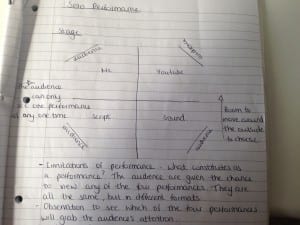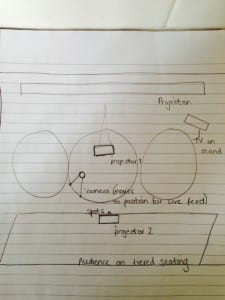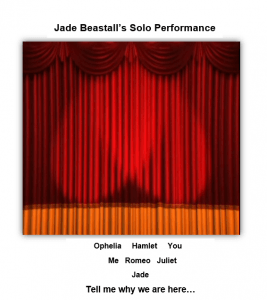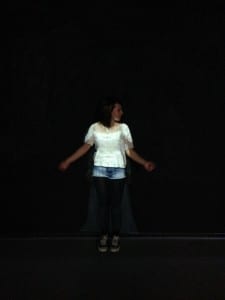Throughout this module I have learnt many things about solo performance. I have learnt about style, atmosphere, indulgence, art and ways of shaping performance spaces. Solo performance is a type of performance which:
“…the solo can be seen as the quintessential form of performance. The audience’s relationship to the soloist is undivided, gratifying the performer’s deepest desires not only to be seen but to be the center (sic) of attention” (Carroll, 1979, 51).
I began my journey into solo performance by questioning which of my personal interests, fears or life experience I could use to create a performance which was personal to me. As I have said, in the post named ‘Watching Others Perform’, there is something about solo performance that brings to life the performer’s deeper personal convictions. Being a shy person I enjoy performing, the moment I take to stage the moment I lose all inhibitions. This notion of character and how drawn in we become to those performing interests me. It is this that began to shape my performance.


My set progressed from a four stage split to a main stage and tiered seating arrangement. This became more useful for the way I wanted to explore different intimacies at different times throughout the performance in the same space. The fast pace of the piece became suited to the static seated audience. I changed my script from being four separate sections to interchanging intimacies, the audience presented with characters in different forms; in their imagination, on screen, in front of them and the prospect but not the chance of becoming one. The script shows how these sections moved into each other. Performance script (final piece) – click on to retrieve script.
I started my performance with a projection of red curtains to tell the audience they were entering a performance space. Like those who wanted to create a personal atmosphere, I chose to create one which made the audience feel like they were about to watch a show. They were presented with a small flyer as a programme note so they were aware of the performance content.

The sound of my voice indicated the start of the performance, with me asking the audience to image the character of Ophelia.
I wanted to distance them from the character, with it beginning only in their mind. Once I was stood in front of them, I questioned who I was and whether I was Ophelia. Taking on the character of Ophelia shortly after gave them a close representation of a character. I questioned whether they then felt close to a small extract of a character they saw directly in front of them.
When I last wrote about Tim Crouch I mentioned that he says in his introduction to An Oak Tree: “…we can have all sorts of conversations about the phenomena of [performance]: about the live qualities of theatre, how it happens right in front of you” (Crouch, 2005, 6). The projection of Ophelia tests this perception as I move in and out allowing my white dress to become a canvas for the mediated version of Ophelia, showing this idea that performances are not always completely live, as seen in a previous post when the RSC showed the balcony scene of Romeo and Juliet on Youtube. It also tests the idea that Shakespeare’s characters are performed on so many occasions that we could become less connected to it.

This idea was something Bertolt Brecht enjoyed to highlight when he created the alienation effect and allowed his performers to move out of character whilst on stage. These ideas began to shape the essence of my performance, bringing to attention many questions about the ‘character’.
When I put on my jacket, I was essentially myself. It is in these moments that I addressed the audience. Taking inspiration from Thom Pain, I chose to ask the audience questions, get members up onto the stage and then tell them to sit down. This was something which allowed me to interact with the audience, breaking down that fourth wall of performance. However, they never became a part of the performance, because as I have said, I am the performer. These ideas both brought the audience closer and created that intended barrier, hoping to highlight that those on stage are the characters.
Throughout, I wanted to link the different intimacies. An example would be when Juliet entered the screen and asked for Romeo: “O Romeo, Romeo! Wherefore are thou Romeo?” (Shakespeare, 2002, 2:2, 31). The character on the chair I was creating then became Romeo, as if the two mediums were interacting. In the final stage of the performance I took the camera and showed my facial expression. Doing this transitioned from me in the jacket to the final closing performance of Juliet attempting suicide in Romeo and Juliet. Although the audience were expected to be drawn into Juliet, there was a distancing through the medium of the screen and the way I started with ‘I want to show you something’. Like when Brecht’s characters described the action and became a part of it in character, I transitioned from me to Juliet as a way distancing the audience from the emotional connection.
Overall, I am pleased with the outcome of the performance. What started as an idea of portraying my enjoyment of performing, became a complicated mix of intimacy and distancing shaped finally by the ideas of Tim Crouch, Bertolt Brecht and Will Eno’s Thom Pain. These are artists who tend to consider the presence of the audience and break away from the conventions of character storylines. Using media elements to manipulate view became loosely linked to Amy Taubin, this all showing a considerable amount of inspiration from those artists around me. Solo performance did become an expression of my desire, but was shaped by what I read, watched and studied along the course of the module.
Works Cited
Carroll, N. (1979) The Solo Self. The Drama Review: TDR, 23 (1) 51-58.
Crouch, T. (2005) An Oak Tree. London: Oberon Books.
Shakespeare W. and Watts, C. (eds.) (2000) Romeo and Juliet. Hertfordshire: Wordsworth Classic Ltd.